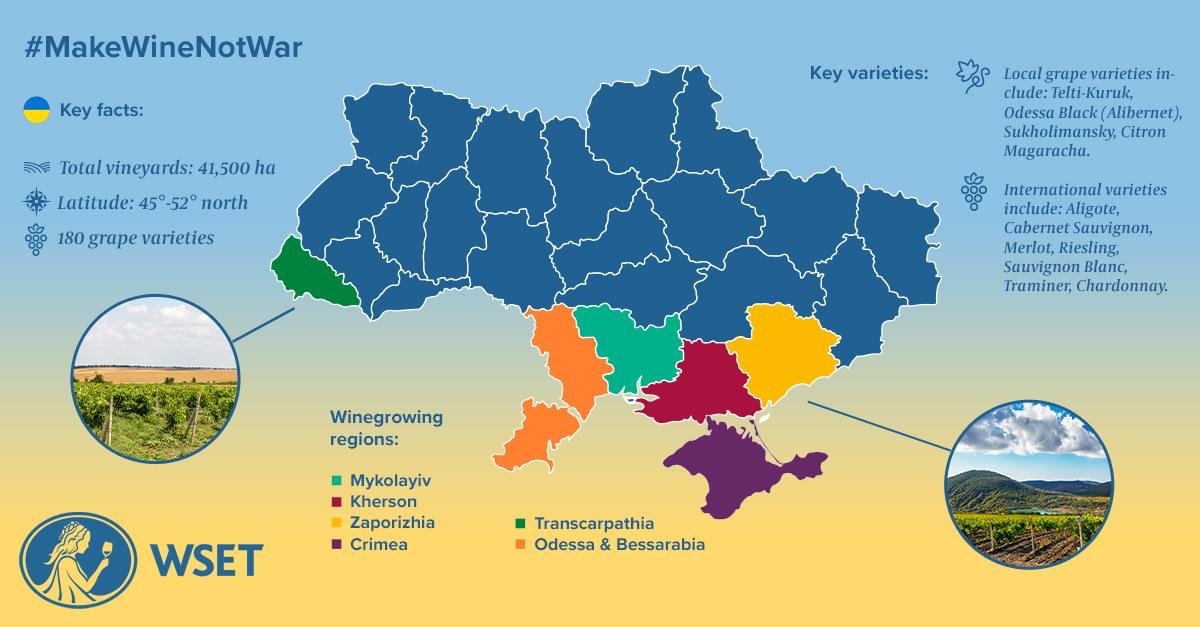Tuesday to Thursday from 6pm to 10pm and Sunday from 1pm to 3pm and from 6pm to 9pm
A regional tasting including 6 wines from the region served by the glass with nibbles.
Price: £35 per person
UKRAINIAN WINE TASTING AVAILABLE FROM 25th of May to 31 of July
or take
Villa Tinta Premium Collection Odessa Premium 2022
Kolonist Odesa Black 2022
Villa Tinta Merlot 2021
Villa Tinta Premium Collection Irsai Oliver 2023
Beykush Chardonnay 2023
Villa Tinta Pinot Grigio 2023
Introduction to Ukrainian Wines for Tasting
Ukraine has a rich and ancient winemaking heritage, dating back over 2,000 years to the times of the Greeks and Romans who cultivated vines along the northern shores of the Black Sea. Despite historical interruptions—from wars to Soviet collectivization—modern Ukrainian winemaking is experiencing a renaissance, blending tradition with innovation. The country’s key wine regions include Odesa, Mykolaiv, Zakarpattia, and Crimea, each offering distinct microclimates and soils ideal for different grape varieties. Native grapes like Odesa Black (a cross of Alicante Bouschet and Cabernet Sauvignon) thrive alongside international classics such as Merlot, Chardonnay, and Pinot Grigio. Ukrainian vintners are gaining recognition for producing expressive, terroir-driven wines with a strong sense of place. Today, Ukraine stands proudly among emerging European wine producers, offering both uniqueness and quality.
Grape Varieties
Ukraine cultivates both international favorites like Chardonnay, Merlot, Pinot Grigio, and Cabernet Sauvignon, and unique local varieties. Highlights include:
Odesa Black – a bold red, native to Ukraine
Sukholymanskyi – a dry white grape developed locally
Irsai Oliver – a fragrant Hungarian varietal that thrives in Ukrainian soil
Winemaking & Aging Process
Ukrainian producers use a range of aging techniques—from stainless steel tanks to oak barrels—to craft expressive wines. Whites like Chardonnay and Pinot Grigio are often fermented and aged in steel to preserve freshness, while reds such as Merlot and Odesa Black may be aged in French or Ukrainian oak, adding structure, spice, and depth. Premium wines may see 6–18 months of barrel aging before release.
Ukrainian wines are gaining global recognition for their authenticity, freshness, and distinctive character. With passionate producers and ideal terroirs, the future of Ukrainian wine looks bright.
Ukrainian Wine Regions:
Kolonist Odesa Black 2022
A bold, inky red made from the native Odesa Black grape. Expect dark berry fruit, a hint of spice, and structured tannins. It’s a uniquely Ukrainian wine, full-bodied and ideal for those who enjoy rich, robust reds.Beykush Chardonnay 2023
A fresh and elegant white wine with citrus and green apple notes, lightly touched by oak aging. Grown near the Black Sea, this Chardonnay showcases a coastal freshness and balanced acidity.Villa Tinta Merlot 2021
Smooth and fruit-forward, this Merlot delivers ripe plum, soft tannins, and a touch of cocoa. A classic expression of the varietal with a Ukrainian twist of minerality from the local soils.Villa Tinta Pinot Grigio 2023
Crisp and light, with floral aromas and flavors of pear, melon, and a hint of citrus zest. This refreshing white is perfect as an aperitif or with lighter fare.Villa Tinta Premium Collection Irsai Oliver 2023
A fragrant white wine from an aromatic Hungarian grape variety, Irsai Oliver. Bursting with notes of elderflower, muscat, and tropical fruit, it’s both vibrant and easy-drinking.Villa Tinta Premium Collection Odessa Premium 2022
A premium red blend showcasing deep color, complex layers of dark fruit, spice, and a silky finish. A refined and modern wine that reflects the quality potential of southern Ukrainian terroir.
We are looking forward to see you!



